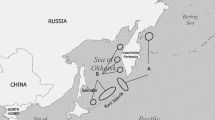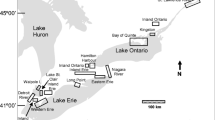Abstract
In this study, liver samples of the European otter (Lutra lutra), great cormorant (Phalacrocorax carbo), and European catfish (Silurus glanis) from along the Loire River (France) were analyzed for organochlorine pesticides, polychlorinated biphenyls (PCBs), trace elements (lead, cadmium, copper, and mercury), 134Cs, and 137Cs. Organochlorine compounds were found in 100 % of the samples. Residue level of PCBs in these predators was the highest followed by DDTs and endosulfan, and maximal PCB values reached 1.61, 1.96, and 0.28 mg/kg wet weight for cormorants, otters, and catfish, respectively. DDTs, endosulfan, and lindane were the abundant pesticides in the livers of these predators. Concentrations of copper, lead, and cadmium in the livers of top predators were generally low; a potentially toxic level of lead was found in only one cormorant (34.9 mg/kg dry weight). Mean mercury concentrations in cormorant, otter, and catfish livers were 5.47, 4.68, and 2.71 mg/kg dry weight, respectively, and exceeded toxic thresholds for more than 40 % of the cormorants. Levels of organochlorine compounds and trace elements in these predators are generally below known toxic thresholds, but potential combined effects are not studied and warrant more investigations.


Similar content being viewed by others
References
Bouchard JP (2007) La restauration des poissons migrateurs du bassin de la Loire : l′aménagement des seuils des centrales électriques. Hydroécologie appliquée 13:131–147
Carrasco L, Barata C, García-Berthou E, Tobias AM, Bayona J, Díez S (2011) Patterns of mercury and methylmercury bioaccumulation in fish species downstream of a long-term mercury-contaminated site in the lower Ebro River (NE Spain). Chemosphere 84:1642–1649
Cheng DX, Yang ZZ, Wang XT, Sun YZ, Xu XB (2006) Organochlorine pesticides in tissues of catfish (Silurus asotus) from Guanting Reservoir, People’s Republic of China. Bull Environ Contam Toxicol 76:766–773
Conroy JWH, Chanin PRF (2000) The status of the Eurasian otter (Lutra lutra) in Europe. A review. J Int Otter Survi Fund 1:7–28
Erdogrul Ö, Covaci A, Schepens P (2005) Levels of organochlorine pesticides, polychlorinated biphenyls and polybrominated diphenyl ethers in fish species from Kahramanmaras, Turkey. Environ Int 31:703–711
Evans RD, Addison EM, Villeneuve JY, MacDonald KS, Joachim DG (2000) Distribution of inorganic- and methyl-mercury among tissues in mink (Mustela vison) and otter (Lutra canadensis). Environ Res 84:133–139
Fabczak J, Szarek J, Markiewicz K, Markiewicz E (2003) Cormorant as a lead contamination bio-indicator in the water environment. Cormorant Res Group Bull 5:40–44
Falandysz J, Wyrzykowska B, Strandberg L, Puzyn T, Strandberg B, Rappe C (2002) Multivariate analysis of the bioaccumulation of polychlorinated biphenyls (PCBs) in the marine pelagic food web from the southern part of the Baltic Sea. Poland J Environ Monit 4:929–941
Fossi M, Massi A, Lari A, Marsili L, Focardi S, Leonzio C et al (1995) Interspecies differences in mixed function oxidase activity in birds: relationship between feeding habits, detoxication activities and organochlorine accumulation. Environ Pollut 90:15–24
Goutner V, Becker P, Liordos V (2011) Organochlorines and mercury in livers of great cormorants (Phalacrocorax carbo sinensis) wintering in northeastern Mediterranean wetlands in relation to area, bird age, and gender. Sci Total Environ 409:710–718
Gulakov AV (2014) Accumulation and distribution of 137Cs and 90Sr in the body of the wild boar (Sus scrofa) found on the territory with radioactive contamination. J Environ Radioact 127:171–175
Guruge KS, Tanabe S (1997) Congener specific accumulation and toxic assessment of polychlorinated biphenyls in common cormorants, Phalacrocorax carbo, from Lake Biwa, Japan. Environ Pollut 96:425–433
Guruge KS, Tanabe S, Fukuda M, Yamagish S, Tatsukawa R (1997) Accumulation pattern of persistent organochlorine residues in common cormorants (Phalacrocorax carbo) from Japan. Mar Pollut Bull 34:186–193
Gutleb AC, Kranz A, Nechay G, Toman A (1998) Heavy metal concentration in livers and kidneys of the otter (Lutra lutra) from central Europe. Bull Environ Contam Toxicol 60:273–279
Harding LE, Harris ML, Elliot JE (1998) Heavy and trace metals in wild mink (Mustela vison) and river otter (Lontra canadensis) captured on rivers receiving metals discharges. Bull Environ Contam Toxicol 61:600–607
Houserova´ P, Kuban V, Kracmar S, Sitko J (2007) Total mercury and mercury species in birds and fish in an aquatic ecosystem in the Czech Republic. Environ Pollut 145:185–194
Hyvärinen H, Tyni P, Nieminen P (2003) Effects of moult, age, and sex on the accumulation of heavy metals in the otter (Lutra lutra) in Finland. Bull Environ Contam Toxicol 70:278–284
Jensen S, Kihlstrom JE, Olsson M, Lundberg C, Ordberg J (1977) Effects of PCB and DDT on mink (Mustela vison) during the reproductive season. Ambio 6:239
Kannan K, Corsolini S, Imagawa T, Focardi S, Giesy JP (2002) Polychlorinated-naphthalenes, -biphenyls, -dibenzo-p-dioxins, -dibenzofurans and p, p′-DDE in bluefin tuna, swordfish, cormorants and barn swallows from Italy. Ambio 31:207–211
Kannan K, Kajiwara N, Watanabe M, Nakata H, Thomas NJ, Stephenson M et al (2004) Profiles of polychlorinated biphenyl congeners, organochlorine pesticides, and butyltins in southern sea otters and their prey. Environ Toxicol Chem 23:49–56
Koop D, Cucheroussset J, Syväranta J, Martino A, Céréghino R, Santoul F (2009) Trophic ecology of the pikeperch (Sander lucioperca) in its introduced areas: a stable isotope approach in southwestern France. Compte rendus Biologie 332:741–746
Kruuk H, Conroy JWH (1996) Concentrations of some organochlorine in otters (Lutra lutra) in Scotland: implications for populations. Environ Pollut 92:165–171
Kruuk H, Conroy JWH, Webb A (1997) Concentrations of mercury in otters (Lutra lutra L.) in Scotland in relation to rainfall. Environ Pollut 96:13–18
Lanszki J, Orosz E, Sugár L (2009) Metal levels in tissues of Eurasian otters (Lutra lutra) from Hungary: variation with sex, age, condition and location. Chemosphere 74:741–743
Lemarchand C, Amblard C, Souchon Y, Berny P (2007) Organochlorine compounds (pesticides and PCBs) in scats of the Eurasian otter (Lutra lutra) from an actual expanding population in central France. Water Air Soil Pollut 186:55–62
Lemarchand C, Rosoux R, Berny P (2010) Organochlorine pesticides, PCBs, heavy metals and anticoagulant rodenticides in tissues of Eurasian otters (Lutra lutra) from upper Loire River catchment (France). Chemosphere 80:1120–1124
Leonards PEG, Broekhuizen S, de Voogt P, Van Straalen NM, Brinkman UAT, Cofino WP et al (1998) Studies of bioaccumulation and biotransformation of PCBs in mustelids based on concentration and congener patterns in predators and preys. Arch Environ Contam Toxicol 35:654–665
Lodenius M, Skaren U, Hellstedt P, Tulisalo E (2014) Mercury in various tissues of three mustelid species and other trace metals in liver of European otter from Eastern Finland. Environ MOni Assess 186:325–333
Mason CF (1989) Water pollution and otter distribution: a review. Lutra 32:97–131
Mason CF, Macdonald SM (1986) Otters, ecology and conservation. Cambridge University Press, Cambridge
Mason CF, Madsen AB (1992) Mercury in Danish otters (Lutra lutra). Chemospher 25:865–867
Mason CF, Madsen AB (1993) Organochlorine pesticide residues and PCBs in Danish otters (Lutra lutra). Sci Total Environ 133:73–81
Mason CF, Stephenson A (2001) Metals in tissues of Eurasian otters (Lutra lutra) from Denmark, Great Britain and Ireland. Chemosphere 44:351–353
Matasin Z, Ivanusic M, Orescanin V, Nejedli S, Gajger IT (2011) Heavy metal concentrations in predator fish. Int J Anim Vet Adv 10:1214–1218
Mazej Z, Al Sayegh-Petkovsek S, Pokorny B (2010) Heavy metal concentrations in food chain of Lake Velenjsko jezero, Slovenia: an artificial lake from mining. Arch Environ Contam Toxicol 58:998–1007
Mazet A, Keck G, Berny P (2004) PCBs in fish of the Ardeche river: potential implications for the survival of the otter (Lutra lutra). Bull Environ Contam 72:784–790
Mazet A, Keck G, Berny P (2005) Concentrations of PCBs, organochlorine pesticides and heavy metals (lead, cadmium, and copper) in fish from the Drôme River: potential effects on otters (Lutra lutra). Chemosphere 61:810–816
Misztal-Szkudlinska M, Szefer P, Konieczka P, Namiesnik J (2011) Biomagnification of mercury in trophic relation of great cormorant (Phalacrocorax carbo) and fish in the Vistula Lagoon, Poland. Environ Monit Assess 176:439–449
Nam DH, Anan Y, Ikemoto T, Okabe Y, Kim EY, Subramanian A et al (2005) Specific accumulation of 20 trace elements in great cormorants (Phalacrocorax carbo) from Japan. Environ Pollut 134:503–514
Olsson M, Reutergårdh L, Sandegren F (1981) Var är uttern? Sveriges Natur 6:234–240
Ramade F (2007) Introduction à l′écotoxicologie. Edition Tech et Doc, Lavoisier
Roos A, Greyerz E, Olson M, Sandegren F (2001) The otter (Lutra lutra) in Sweden—population trends and relation to DDT and total PCB concentrations during 1968–99. Environ Pollut 111:457–469
Ruiz-Olmo J, Lafontaine L, Prignioni C, Lopez-Martin JM, Santos-Reis M (2000) Pollution and its effects on otter population in south-western Europe. J Int Otter Survival Fund 1:63–82
Saeki K, Okabe Y, Kim EY, Tanabe S, Fukuda M, Tatsukawa R (2000) Mercury and cadmium in common cormorants (Phalacrocorax carbo). Environ Pollut 108:249–255
Skoric S, Visnjic´-Jeftic Z, Jaric I, Djikanovic V, Mickovic B, Nikcevic M et al (2012) Accumulation of 20 elements in great cormorant (Phalacrocorax carbo) and itsmainprey, common carp (Cyprinus carpio) and Prussian carp (Carassius gibelio). Ecotoxicol Environ Saf 80:244–251
Sleema J, Cristol DA, White AE, Evers DC, Gerhold RW, Keel MK (2010) Mercury poisoning in a free-living Northern River Otter (Lontra canadensis). J Wild Dis 46(3):1035–1039
Smit MD, Leonards PEG, De Jongh AW, Van Hattum BG (1998) Polychlorinated biphenyls in Eurasian Otter (Lutra lutra). Rev Environ Contam Toxicol 157:95–130
Squadrone S, Prearo M, Brizio P, Gavinelli S, Pellegrino M, Scanzio T et al (2013) Heavy metals distribution in muscle, liver, kidney and gill of European catfish (Silurus glanis) from Italian Rivers. Chemosphere 90:358–365
Subotić S, Spasić S, Višnjić-Jeftić Ž, Hegediš A, Krpo-Ćetković J, Mićković B et al (2013) Heavy metal and trace element bioaccumulation in target tissues of four edible fish species from the Danube River (Serbia). Ecotoxicol Environ Saf 98:196–202
Acknowledgments
We are most grateful to PLATIN’ (Plateau d’Isotopie de Normandie) core facility for all element and isotope analyses used in this study, the French ONCFS. This study was financially supported by: European Commission (FEDER Grant no. 38462), Agence de l’Eau Loire-Bretagne, Région Centre and VetAgro Sup.
Author information
Authors and Affiliations
Corresponding author
Electronic Supplementary Materials
Below is the link to the electronic supplementary material.
Electronic Supplementary data
Difference in concentrations of cadmium (2a) and mercury (2b) between adults and young otters (dry weight, p > 0.05). Box : median, 1st quartile, 3rd quartile. (ZIP 3 kb)
Rights and permissions
About this article
Cite this article
Alomar, H., Lemarchand, C., Rosoux, R. et al. Concentrations of organochlorine compounds (pesticides and PCBs), trace elements (Pb, Cd, Cu, and Hg), 134Cs, and 137Cs in the livers of the European otter (Lutra lutra), great cormorant (Phalacrocorax carbo), and European catfish (Silurus glanis), collected from the Loire River (France). Eur J Wildl Res 62, 653–661 (2016). https://doi.org/10.1007/s10344-016-1038-5
Received:
Revised:
Accepted:
Published:
Issue Date:
DOI: https://doi.org/10.1007/s10344-016-1038-5




